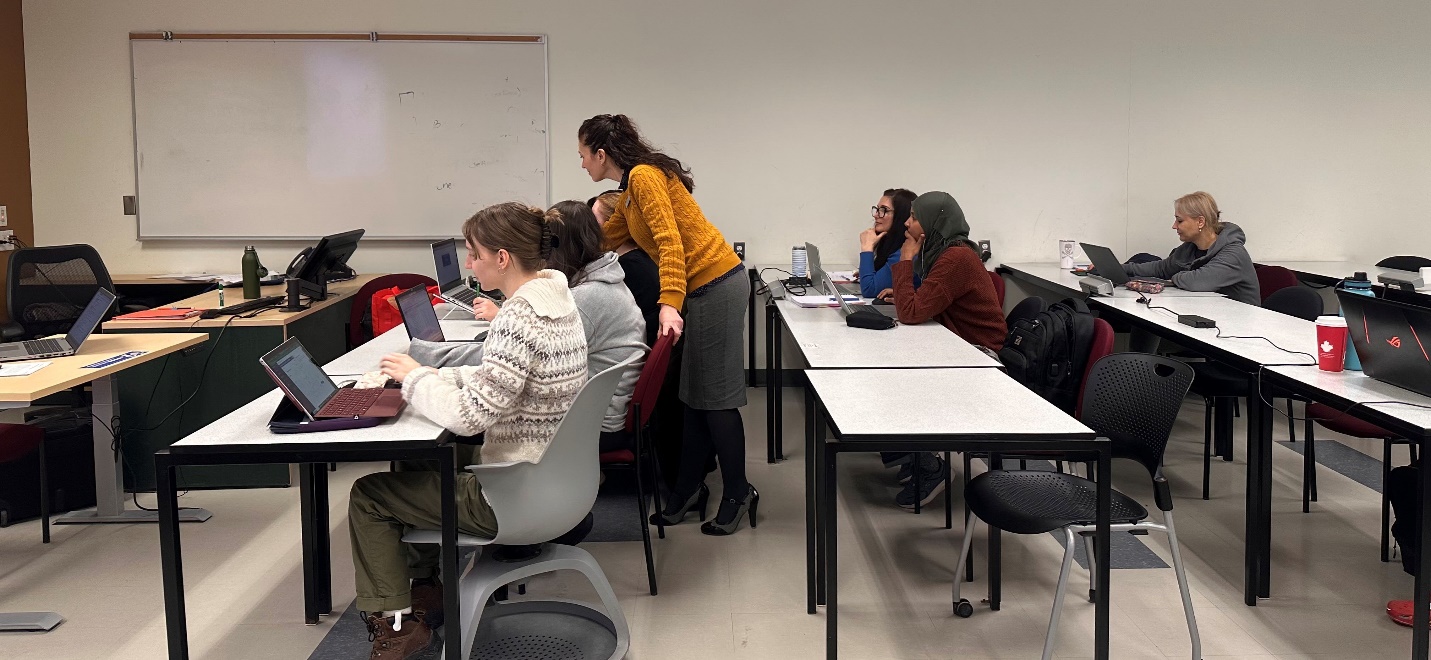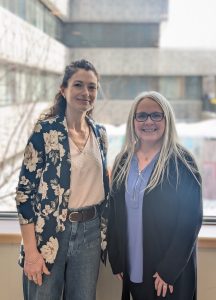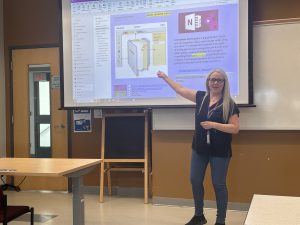3 The One Where We Got Organized
Angela Lyrette and Laura Vena
Collaboratively Creating Classroom Content!


Anik Stark (on right) is the Administrative Coordinator for the Department of Pediatrics, Division of Emergency Medicine at the Children’s Hospital of Eastern Ontario (CHEO). She is also the Chair of the CHEO Staff Forum, the Admin Networking Group Co-Chair, Treasurer for the Association of Administrative Professionals, and the 2023 Canadian Administrative Professional of the Year.
In her role, Anik provides administrative support to more than 50 emergency room physicians with their clinical and academic requirements. She supervises nine administrative professionals in other divisions, through one-on-one check-ins, performance appraisals, approving vacation requests and ensuring adequate support for the teams. She also mentors other administrative professionals and oversees students in workplace assignments and provides feedback.
Professor Laura Vena, (on left) is a full-time Marketing & Management Studies faculty, specializing in teaching office productivity software such as Microsoft Office 365, Adobe Acrobat, and online conferencing tools. As one of the senior faculty teaching in the Office Administration General Certificate, and Office Administration – Health Services Diploma programs, Laura understands how quickly tools and resources used in workplaces need to be adapted, pivoted, and skills updated to meet organizational goals.
The two met in 2022 through the Office Administration Program Advisory Committee (PAC). Anik’s passion for collaborative procedures documentation inspired Laura to connect with her beyond the PAC meetings to learn more about how she was championing the preservation of administrative knowledge at CHEO. They planned for Laura to visit Anik on site at the hospital to observe the team in action. She also was using the opportunity to visit some Office Administration – Health Services Program students who were currently on placement there.
Making the Most of Your Industry Partnership
Before her visit, Laura checked with Anik in advance to find out workplace procedures and policies that might apply to her. Students will benefit from Laura’s preparation and observations for their first day on placement or job.
- Dress code and business acumen – while the office culture at CHEO is usually business professional, the day chosen for the visit was a Friday “Jeans Day”, so Laura was able to dress appropriately for the day. She brought along branded swag for Anik, and special gifts for her students
- Directions and Parking – Anik provided Laura with detailed instructions on where to park, so as to not use space dedicated to patients and partners visiting the hospital, and then came to the entrance to escort her to the office area
- Security & Privacy – as a visitor to an institution where children are receiving critical care and employees have access to confidential patient records, Laura respected protocols as set out by the CHEO team, such as wearing a mask
As you might expect for a hospital for sick children, CHEO’s walls are lined with pictures, murals, and splashes of purple, teal, blue and green jewel tones, their company brand colours. The visit included a quick tour, and then they got down to business. Anik graciously showed Laura how the administrative team utilizes Microsoft OneNote for their collaborative procedures documentation. Anik uses a dashboard to manage her roles (e.g., ED Admin, Admin Coordinator, Staff Forum, Admin Networking Group, AAP, and Algonquin College FICM Project). Laura observed the team using high level organizational tools.
One Note and SharePoint Integration:
- OneNote is used within SharePoint for streamlined task sharing and syncing
- SharePoint team notebooks are synced to desktop versions, enabling offline access
- SharePoint is integrated with File Explorer for enhanced workflow efficiency.
Dashboard Organization:
- Tasks are grouped into major categories (“large buckets”) and further subdivided.
- Systematic use of color coding, conditional formatting, and strikethroughs across Outlook emails, calendars, and spreadsheets to support quick-reference task management.
Payroll Processes:
- Payroll is entered through a customized MS Access database form to streamline data input and minimize errors.
Scheduling and Tracking:
- Daily doctor schedules are created by exporting data from the online Petal scheduling system into Excel and printing hard copies.
- Tracking of PD budgets and signature updates is maintained in Excel, allowing year-to-year rollover.
Anik’s future plans include migrating scheduling and document management fully into SharePoint. She recognizes that this process should be gradual, to ensure staff buy-in.
Anik uses OneNote to keep her professional portfolio up to date, incorporating newly acquired professional development certificates, sections for projects she is working on, standardized operational practices, and notes from meetings with mentors/mentees. Laura can ensure students adopt this strategy from their first day in their post-secondary program.
- Create pages for each competency, using their program’s Vocational Learning Outcomes (VLOs), Course Learning Requirements (CLRs), and Essential Employability Skills (EESs) as templates
- As each competency is discovered, developed, and mastered, evidence can be added to the portfolio through the addition of artifacts, such as successful project feedback, completion certificates, and awarded badges
- The addition of a graded self- and peer evaluated component will inspire collaboration, and empower students to develop co-mentorship skills.
Laura was so impressed with Anik’s filing system, she has practically replaced her paper note pad with online notes.
Laura gained a new perspective for using OneNote as a kind of “digital brain”. She has been using the tool to:
- Store standardized grading feedback
- Create and adapt email templates to answer common student questions
- Use templates to organize procedures, especially infrequently used ones
- Document cyclical processes and operational practices
Later in the term, Laura invited Anik for a campus tour, lunch at the student-managed and staffed Restaurant International, and to visit one of her classes. The purpose of the visit was to provide students with practical insights into the use of digital tools for administrative professionals, share best practices for documentation and task management, and offer career development advice for working in healthcare and administrative environments. Anik introduced the students to free tools worth exploring, such as Gamma, and a supportive online community for administrative professionals, #AdminsRock.

During her visit, Anik shared a case study about team challenges over contact list management, illustrating the importance of clear communication and documentation expectations. She gave the class an overview of CHEO’s hiring processes for data entry clerks. She identified pre-interview testing areas, such as letters, spreadsheets, and presentations skills. Applicants who score 70% or higher on these tests advance to the interview stage.
Laura teaches Microsoft 365 tools, including Teams, Outlook, SharePoint, and Excel. To better prepare her students for workplaces such as CHEO, she plans to add Microsoft Loop into the Teams lecture, to ensure students practice and are rewarded for using standardized naming conventions, colour palettes, and using systematic filing processes, such as a Stack Method.
-
- Create badly named files and task students with re-naming them and organizing them by hierarchy individually. Have students compare results with AI generated suggestions
- Initiate small group discussions to compare nomenclature. Determine which documents may require hard copies and why
- Have students select and use a colour palette for a simulated company, selecting colour for branding purposes as well as for file organization; such as indicators of urgent, day-to-day, and complete tasks
To prepare for Anik’s visit, Laura tasked her students to create potential questions in advance. Students were particularly interested in:
Private Sector Experience: Anik’s background with multiple stakeholders enhanced her understanding of diverse working environments.
Lessons on Assumptions: She emphasized the risks of assuming technical competencies without confirming needs and providing appropriate guidance.
Student Preparation Advice: She encouraged ongoing learning and professional networking to build readiness for hospital and healthcare settings.
Skills Transferable to the Workplace
Students can learn to use artificial intelligence (AI) as a tool, not a crutch. Students should leverage technology to:
- drive efficiency, minimize redundancy, and find potential issues early in assignment preparation
- Streamline processes – practicing effective time management skills, reducing cognitive load
- Develop a professional business persona, and to identify steps for overcoming challenges
Both Laura’s site visit and Anik’s class visit were highly successful. Laura confirmed that much of her course and program’s content was meeting the needs of students preparing for the medical administrative workforce. In class, students were actively engaged, asked insightful questions, and showed enthusiasm during the OneNote demonstrations. The session provided valuable, real-world applications of administrative skills that directly support student career readiness.
Media Attributions
- Laura Vena and Anik Stark at CHEO
- Anik Stark visits Laura Vena’s class

